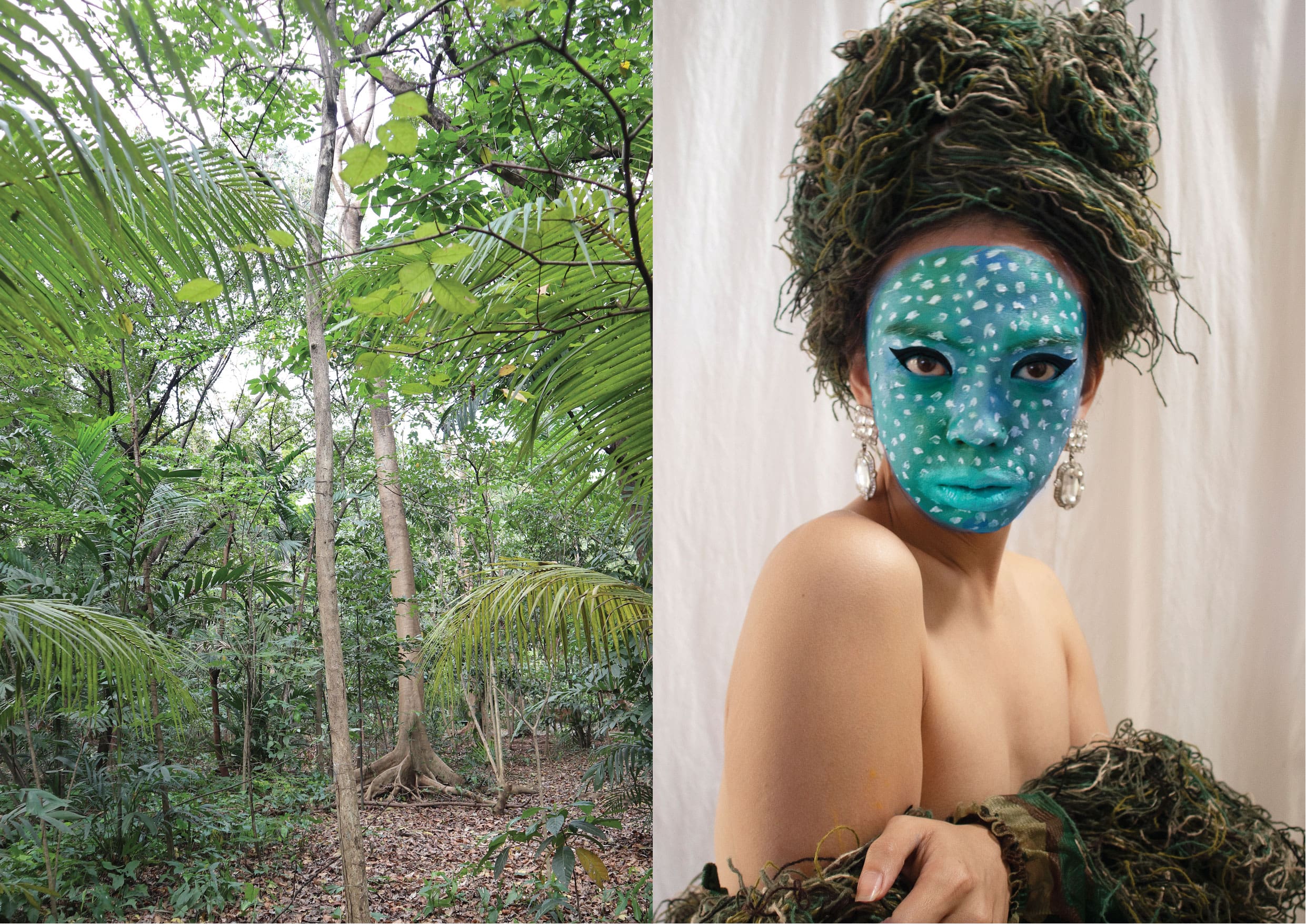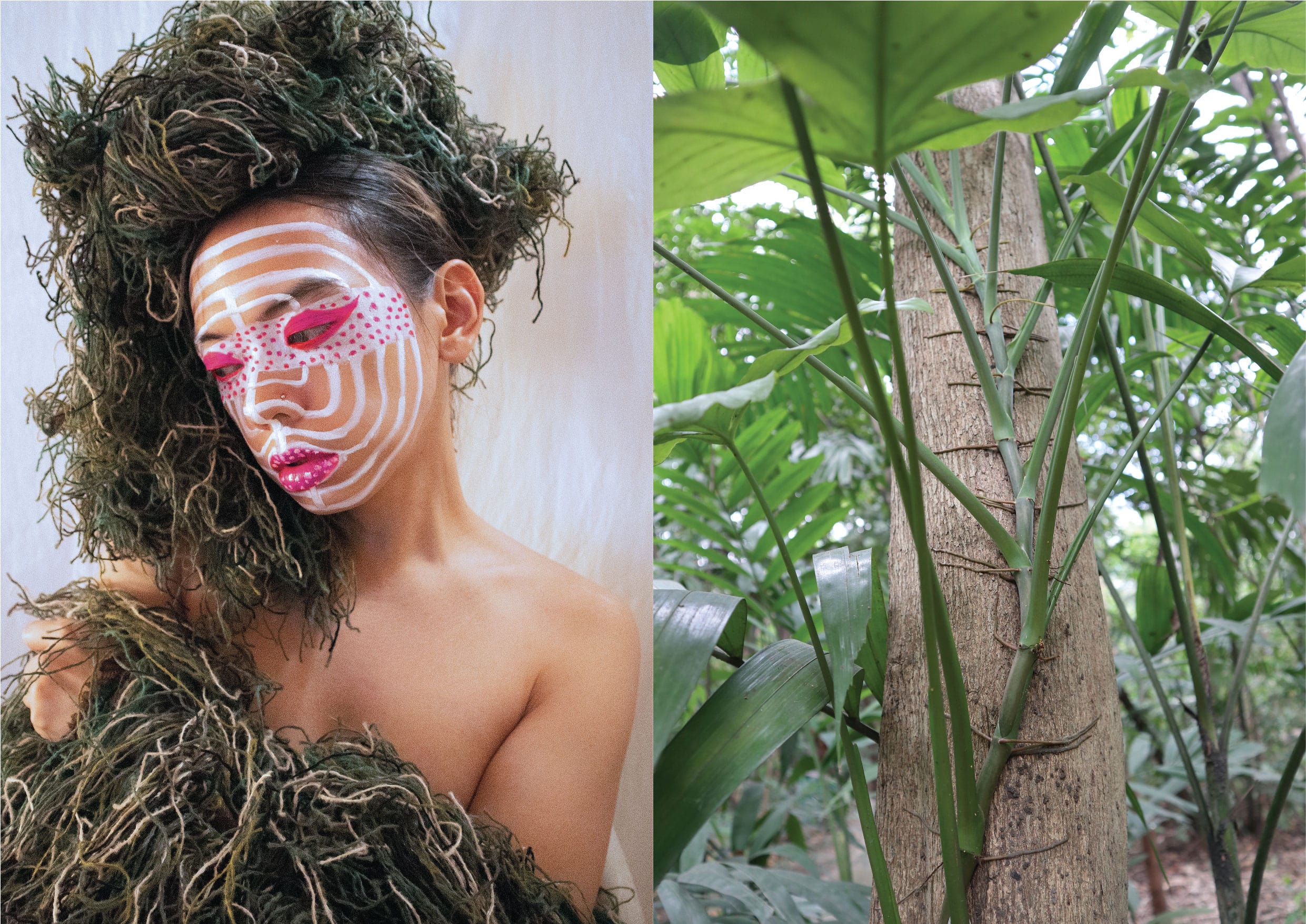VOLUME 2 / ARTICLE 07 ︎
![]()

BABAYLAN REALISM
Written by Alex Quicho
Visual art by Isola Tong
November 2020
Visual art by Isola Tong
November 2020
Living abroad, I’m sometimes probed on my home country’s gender politics by liberal friends — how is it that such a devoutly Catholic country tolerates people living openly, between genders? Outsiders might wish to project upon the Philippines an air of festive sexual permissiveness, all the more intensified by religious taboo and real danger. All too often, the stereotype is pursued by sex tourists from so-called liberal Western democracies who, due to gendered and racial power dynamics, feel more free to pursue their compulsions in the tropics. Our current president, a misogynist fancying himself a gangster and running his administration accordingly, only enables such actions — just this year, pardoning the US Marine who brutally murdered Jennifer Laude, a 26-year-old Filipina described by her family as “fearless, beautiful, [and a] generous daughter,” in his hotel room when he discovered she was trangender. In the Philippines, nearly half of all adult women have experienced domestic violence in their lifetime, while transgender people face violence and harassment both in and out of the home. And while same-sex relations aren’t criminalised, there is legislation against “scandalous conduct” and penalties for gender non-conformity.
“In the Philippines, nearly half of all adult women have experienced domestic violence in their lifetime, while transgender people face violence and harassment both in and out of the home.”

So even though our schoolyard chants openly recognised four genders — girl, boy, baklâ, tomboy, and even then, not without hierarchy — it’s a stretch to claim that any LGBTQ+ person is able to live freely, without fear of harm. But that’s not to say that people don’t live openly; the cities, especially, have been home to thriving queer scenes for decades. Back in the 1990s, my parents ran a nightclub, notorious as a cruising spot, together with a queen named Louie Cruz. Some of my earliest memories are of my mom and I sitting side by side in salon chairs as our hairdresser, a slender third-gender woman with pin-straight hair, deliberated on our cuts. She’d put her high heel on the lever and pump until my tiny face was level with the mirror, using the pin-sharp end of her comb to part my hair in the middle, silver scissors shearing air. All around me, women sat under huge bubble dryers, paging through tabloids as their hair marinated in coconut oil or took the form of pastel curlers. The dim, circular room gave off an aura of dead time, but I felt cared for, ensconced in a puffy cloud of femininity. I don’t remember her name, now, just the sour floral tang of the salon floor, and the high femme performance that I — a kid frequently teased, not inaccurately, for being a tomboy — felt enraptured by yet curiously distant from. As I grew up, I began to perceive Filipinx sexual freedom as something that still superceded all the horrific violence, the back-room talk of ‘Catholic girls,’ the domestic slavery, the old white men who checked into the hotel we lived in with the express goal of taking home underage girls — all the ways that the global order, which located our “developing nation” at the bottom of the capitalist ladder, sought to exploit and oppress Filipinx bodies. It erased even the sting of the Facebook message I received just days after I opened an account, marking our recent immigration to Canada, which asked the racialised, derogatory question: “are you a ladyboy?” Which is to say, there’s still a power within Filipinx sexual culture that exceeds the brutality of whiteness — pre-existing, surviving, and outlasting the colonial Catholic framework of control, punishment, and repression of gender nonconformity.
“Pre-colonial gender, however, wasn’t ascribed to sex or sexuality; rather, one’s gender was a free choice for every individual, based on which ‘energy’ resonated with them most.”
It’s not entirely accurate to classify early Philippine society as matriarchal. But it’s true that tribes were jointly headed by datu, political leaders who embodied ‘male’ energy in the form of black magic, and babaylan, shamans who channeled the ‘feminine’ realm of natural forces. Most babaylan practiced divination, healing, herbalism, and séance; many also trained in combat. Pre-colonial gender, however, wasn’t ascribed to sex or sexuality; rather, one’s gender was a free choice for every individual, based on which ‘energy’ resonated with them most. For those who aspired to become babaylan, the long journey towards shamanism started with a ‘call’ — in other words, a life-altering event: an all-consuming illness, the chance survival of a dangerous situation. If you suddenly wished to live as another gender, well, that would be the call in itself; in fact, there’s evidence that pre-colonial Filipinx who transitioned between genders were spared other initiation rites designed to test the psyche — walking on one’s knees for miles, for example, or being submerged in water overnight — speaking to the mental fortitude the process requires, whether historically or in the modern day. (Something of a collective desire for masochistic transcendence persists, too, in Philippine society, in the form of popular crucifixion festivals, long pilgrimages, and self-flagellations.)
When the Spanish arrived in 1565 to colonise the indigenous sultanates, rajahnates, and kingdoms scattered across the islands, the sight of all-powerful babaylan distressed the missionaries tasked with converting the local population to Catholicism — a project of control that went hand-in-hand with the Spaniards’ military operation. With organised religion came a gender binary, enforced patriarchy, and a sense of boot-licking shame; the apple was force-fed in Eden, transforming the respected and wealthy babaylan into the bruja that struck fear into settler children’s hearts. While some babaylan led spirited uprisings against the colonisers, most went underground out of necessity. The tradition of shamanism — as with many elements of indigenous animism — persisted just beneath the surface of colonial society, in spite of Church efforts to eradicate such practices.
![]()
Today, indigenous babaylan continue to lead and protect their communities against mining, deforestation, and other behemoths of industry. As land defenders, many babaylan have been classed as terrorists by the Duterte government, whose actions have criminalised indigenous survival once again, moving the Philippines to the top of the list of countries most deadly for environmental activists. But even as indigenous babaylan engage in serious struggle against neocolonial motives, Philippine media and creative circles are reviving the philosophy of babaylan in the cities — subjecting it, like many other indigenous traditions the world over, to well-intentioned gentrification. The Center for Babaylan Studies, run by urban and diasporic Filipinas, has been applauded in the press for bringing indigenous Filipinx practices to “mainstream” culture. The term is sometimes used to denote a kind of Filipinx ‘girlboss,’ applying the ‘divine feminine’ within the colonial gender binary: former president Corazon Aquino, who headed the fledgeling Philippine democracy after the fall of the Marcos dictatorship, is often referred to as a contemporary babaylan — as is former president Gloria Macapagal-Arroyo, albeit under a much less noble public record.
The idea that “trauma is epigenetic” is one now well-circulated, even fetishised, as a metaphor among people studying the significant aftereffects of colonialism, regardless of the flimsiness of the science that it rests on. That the intense extraction, subjugation, and cultural erasure enacted on a people such as mine would remain, not just latently submerged in one’s memory, but in the very code of one’s genetic material is a powerful, if terrifying, concept — one that allows inheritors of generational trauma to accept how events that preceded their birth could still texture their present reality. If that’s the case, then what else of history could lie latent in our bodies, submerged? Modern Philippine society retains, blissfully, the imprint of its pre-colonial beginnings — but it has also been made in the image of its first apocalyptic violence. The babaylan, in her many forms, stands at the centre of this tension.
When the Spanish arrived in 1565 to colonise the indigenous sultanates, rajahnates, and kingdoms scattered across the islands, the sight of all-powerful babaylan distressed the missionaries tasked with converting the local population to Catholicism — a project of control that went hand-in-hand with the Spaniards’ military operation. With organised religion came a gender binary, enforced patriarchy, and a sense of boot-licking shame; the apple was force-fed in Eden, transforming the respected and wealthy babaylan into the bruja that struck fear into settler children’s hearts. While some babaylan led spirited uprisings against the colonisers, most went underground out of necessity. The tradition of shamanism — as with many elements of indigenous animism — persisted just beneath the surface of colonial society, in spite of Church efforts to eradicate such practices.

Today, indigenous babaylan continue to lead and protect their communities against mining, deforestation, and other behemoths of industry. As land defenders, many babaylan have been classed as terrorists by the Duterte government, whose actions have criminalised indigenous survival once again, moving the Philippines to the top of the list of countries most deadly for environmental activists. But even as indigenous babaylan engage in serious struggle against neocolonial motives, Philippine media and creative circles are reviving the philosophy of babaylan in the cities — subjecting it, like many other indigenous traditions the world over, to well-intentioned gentrification. The Center for Babaylan Studies, run by urban and diasporic Filipinas, has been applauded in the press for bringing indigenous Filipinx practices to “mainstream” culture. The term is sometimes used to denote a kind of Filipinx ‘girlboss,’ applying the ‘divine feminine’ within the colonial gender binary: former president Corazon Aquino, who headed the fledgeling Philippine democracy after the fall of the Marcos dictatorship, is often referred to as a contemporary babaylan — as is former president Gloria Macapagal-Arroyo, albeit under a much less noble public record.
The idea that “trauma is epigenetic” is one now well-circulated, even fetishised, as a metaphor among people studying the significant aftereffects of colonialism, regardless of the flimsiness of the science that it rests on. That the intense extraction, subjugation, and cultural erasure enacted on a people such as mine would remain, not just latently submerged in one’s memory, but in the very code of one’s genetic material is a powerful, if terrifying, concept — one that allows inheritors of generational trauma to accept how events that preceded their birth could still texture their present reality. If that’s the case, then what else of history could lie latent in our bodies, submerged? Modern Philippine society retains, blissfully, the imprint of its pre-colonial beginnings — but it has also been made in the image of its first apocalyptic violence. The babaylan, in her many forms, stands at the centre of this tension.
ABOUT THE AUTHOR
Alex Quicho is a writer in London. Born in Manila and raised in Vancouver, BC, she studied critical writing at the Royal College of Art. Her book on drones in contemporary art, Small Gods, is forthcoming from Zero Books in 2021.
Alex Quicho is a writer in London. Born in Manila and raised in Vancouver, BC, she studied critical writing at the Royal College of Art. Her book on drones in contemporary art, Small Gods, is forthcoming from Zero Books in 2021.
ABOUT THE VISUAL ARTIST
Isola Tong is a transfeminine architect and visual artist based in Manila, Philippines.
Isola Tong is a transfeminine architect and visual artist based in Manila, Philippines.








